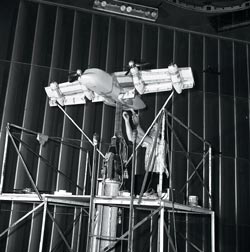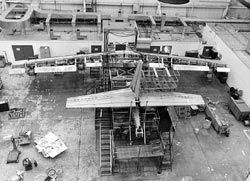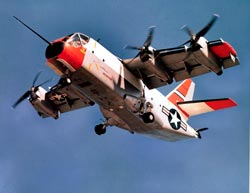|
Each team member assigned a Program Manager as well as key Engineering and Manufacturing personnel. The propeller manufacturer, Hamilton Standard, was selected following a major Vought in-house competition. It was necessary to select the propeller manufacturer at the earliest possible time because propeller thrust performance directly impacted hovering performance, and propeller pitch control was an integral part of the airplane primary control system..
 Contractually specified test programs verified the airplane designs. Among these were: additional wind tunnel tests both at Vought and NASA (National Aeronautics and Space Administration, Langley Field, Virginia); flight control tests on a simulator with a computer to allow pilot-in-the-loop testing; structural tests; propeller performance verification tests; and propulsion system tests with a dynamic test rig. This rig was at Hiller, and included four T64-GE-1 engines, Hamilton Standard 15.6-foot diameter main propellers, the tail propeller, and all associated gear boxes and shafting. Contractually specified test programs verified the airplane designs. Among these were: additional wind tunnel tests both at Vought and NASA (National Aeronautics and Space Administration, Langley Field, Virginia); flight control tests on a simulator with a computer to allow pilot-in-the-loop testing; structural tests; propeller performance verification tests; and propulsion system tests with a dynamic test rig. This rig was at Hiller, and included four T64-GE-1 engines, Hamilton Standard 15.6-foot diameter main propellers, the tail propeller, and all associated gear boxes and shafting.  Before first flight, a complete “tied down” airplane (No. 1 airplane) with all propulsion and control systems installed was subjected to a complete spectrum of powered tests. These included various power settings, propeller speeds and wing incidence angles from zero to 90 degrees with tail propeller engaged and disengaged, as appropriate. Following the tie-down tests, all propulsion system components were disassembled and inspected by both contractor and military personnel for undue wear or indications of fatigue. Any necessary changes were incorporated and the first flying airplane was cleared for flight. No. 2 airplane made the first flight on September 26, 1964. Before first flight, a complete “tied down” airplane (No. 1 airplane) with all propulsion and control systems installed was subjected to a complete spectrum of powered tests. These included various power settings, propeller speeds and wing incidence angles from zero to 90 degrees with tail propeller engaged and disengaged, as appropriate. Following the tie-down tests, all propulsion system components were disassembled and inspected by both contractor and military personnel for undue wear or indications of fatigue. Any necessary changes were incorporated and the first flying airplane was cleared for flight. No. 2 airplane made the first flight on September 26, 1964.
 The contractor flight test program identified the speed/altitude structural and aerodynamic operating envelopes as well as the flap setting/wing incidence program for V/STOL operations. Recommended pilot operating procedures were developed for both normal and emergency flight. Hardware and flight deficiencies were identified and corrected prior to delivery for military testing. The contractor flight test program identified the speed/altitude structural and aerodynamic operating envelopes as well as the flap setting/wing incidence program for V/STOL operations. Recommended pilot operating procedures were developed for both normal and emergency flight. Hardware and flight deficiencies were identified and corrected prior to delivery for military testing.
The XC-142A was the largest and fastest VTOL transport airplane flying at that time. It achieved more than 400 miles per hour at cruise altitude during flight testing. The payload was carried in a cargo compartment that was 30 feet long, 7.5 feet wide and 7 feet high. Two pilots and one crewman/load master made up the flight crew. To accommodate adverse winds, the wing tilted upward more than 90 degrees which allowed the airplane to fly backward at 20 knots. By banking left or right, the airplane could fly sideways at 40 knots.
XC-142A:
VHR-447 V/STOL Proposal
XC-142A Design/Development Program
The Military Operational Test Program
NASA Operations
|